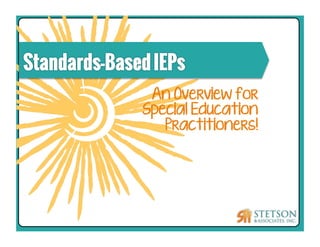
Stetson & Associates Standards-Based IEP Training (Sample Slides)
- 1. An Overview for Special Education Practitioners!
- 2. 5 Challenges? Opportunities? • Crafting PLAAFP based on sure knowledge of enrolled grade level standards • Scaffolding low enough to allow access yet high enough to promote mastery • Teacher expertise and use of progress monitoring • Adjusting instruction to promote mastery • Deep knowledge of strategies for teaching reading and math. Source: Council for Exceptional Children
- 3. Session Agenda Increasing our Understanding of Standards-Based IEP Development • Standards-Based IEP: Legal Basis • Steps for Writing a Standards-Based IEP • Crafting a PLAAFP based on CCSS • Writing Measurable Goals • Writing Short Term Objectives • Progress Monitoring • Questions, Answers and Next Steps
- 4. ● Locate a set of curriculum standards for a specific content area that range from Kindergarten through High School. ● With your colleagues rank the standard by arranging them in sequential order so that each grade level is represented.
- 7. • Go to your assigned Home Group • Read the assigned selection based on your number. • Move to your Expert Group • Complete the note taking tool concerning your assignment. • Return to your Home Group • Share the information.
- 8. As Designed? With Instruc2onal Accommoda2ons ? With Curricular Modifica2ons? With Personal Support? Different Loca2on? Think about how the student can participate in the Common Core Curriculum Standards…
- 9. • Review the documents assigned to you. • How might you use these documents in determining a student’s present level of performance? • Area of Difficulty Student Checklist • Cloze Test • Behavior Checklist • Student Profile • Other??
- 10. Area of Difficulty Checklist Area of Difficulty Student Checklist Student:___________________________________ Directions: Review individual students relative to the areas of difficulty. Mark frequency of difficulty based on observed student academic and behavioral responses. Consider remedial strategies by referring to your “If Student Has Difficulty, Then Try This” sheets. Area of Difficulty Frequent Issue (?) Periodic Issue (?) Not an Issue (?) Suggestions for Improvement: Becoming interested Getting started, give cue to begin work, self-initiative Paying attention to spoken word Following directions Keeping track of materials or assignments Turning in work or assignments Paying attention to printed word Reading textbooks or supplemental materials Completing tasks on time Expressing self verbally Staying on task Staying focused in a group activity Understanding cause/effect, anticipating consequences Seeing relationships Expressing self in writing Drawing conclusions and making inferences Remembering Taking meaningful notes Expressing self in a group or participating Responding to behavioral redirections Self-discipline, or corrects own behavior Learning by listening Working independently Understanding what is read Write legibly Spelling Prepared for class (supplies) Prepared for class (homework)
- 11. • “Annual goals are statements that describe what a child with a disability can reasonably be expected to accomplish within a 12 month period in the child’s special education program. • These goals are skills and/or knowledge that will be mastered, not an activity. • The goals should focus on enabling students to demonstrate academic achievement related to enrolled grade level standards”. Texas Education Agency(2008) Texas Essential Knowledge and Skills (TEKS)-Based Individualized Education Program (IEP) Development: Question and Answer Document
- 12. Component 1: Timeframe Note: The amount of time is SPECIFIED and is described in number of weeks or a certain date for completion Timeframe Conditions Behavior Statement Criterion While it seems obvious that “Annual Goals” implies a one-year timeframe there are many ways the timeframe can be stated. Examples: ● By the end of the fourth grading period… ● In thirty-six instructional weeks… ● By May 31, 20__(or other date)…. ● By the end of the 20__-20__school year… ● By the end of the sixth week grading period…
- 13. Timeframe Conditions Behavior Statement Criterion Component 2: Conditions ● Refers to the manner in which progress toward the goal occurs. ● Describes the specific resources that must be present for a student to reach the goal. ● The condition relates to the behavior being measured. ● They are the “givens” in the goal statement. ● They can be stated or implied or imbedded.
- 14. Behavior Statement Criterion Timeframe Conditions Using your response cards indicate your answer of Yes or No to the following behavior statements: Component 3: Behavior Statement Juan will read…
- 15. Writing a Goal Timeframe Condition Behavior Criteria
- 16. Short-Term Objective Short-Term Objective Short-Term Objective Annual Goal Short Term Objectives or Benchmarks ● They state the steps to be taken between the PLAAFP and Annual Goal. ● They have the same required components as the Annual Goal (Timeframe, Condition, Behavior, Criteria). ● At least two objectives for each goal is suggested. ● They have the same requirement for measurability as the Annual Goal. (Action, Universality, Quantification, Completeness)
- 17. Clear and Measurable Annual Goals that are Standard Based A Progress Monitoring Plan Frequent Assessment Using Multiple Measures Charting and Recording Data Use of Data to Inform and Improve Instruction Quenemoen, R., Thurlow, M., Moen, R., Thompson, S. & Morse, A. B. (2003). Progress monitoring in an inclusive standards-based assessment and accountability system (Synthesis Report 53). Minneapolis, MN: University of Minnesota, National Center on Educational Outcomes. Retrieved [today's date], from the World Wide Web: http://education.umn.edu/NCEO/OnlinePubs/Synthesis53.html
- 19. DIRECT • A direct approach to measuring progress involves the use of objective measures that are observable, clearly scorable, and reference the skill desired (curriculum- based assessment, benchmarks, criterion referenced tests, Teacher made checklists). INDIRECT • An indirect approach to measuring progress involves the use of measures that support the objective measures. (student self monitoring, rubrics accuracy rating etc. AUTHENTIC • An authentic approach to progress monitoring involves the use of measures that further support the student’s progress (anecdotal records, conferences, portfolio, videotaping.
- 20. 14343-G Torrey Chase Blvd Houston, Texas 77014 T 281.440.4220 www.stetsonassociates.com © 2014, Stetson & Associates, Inc. All Rights Reserved